3.7 Metamorphic Rocks
Charlene Estrada
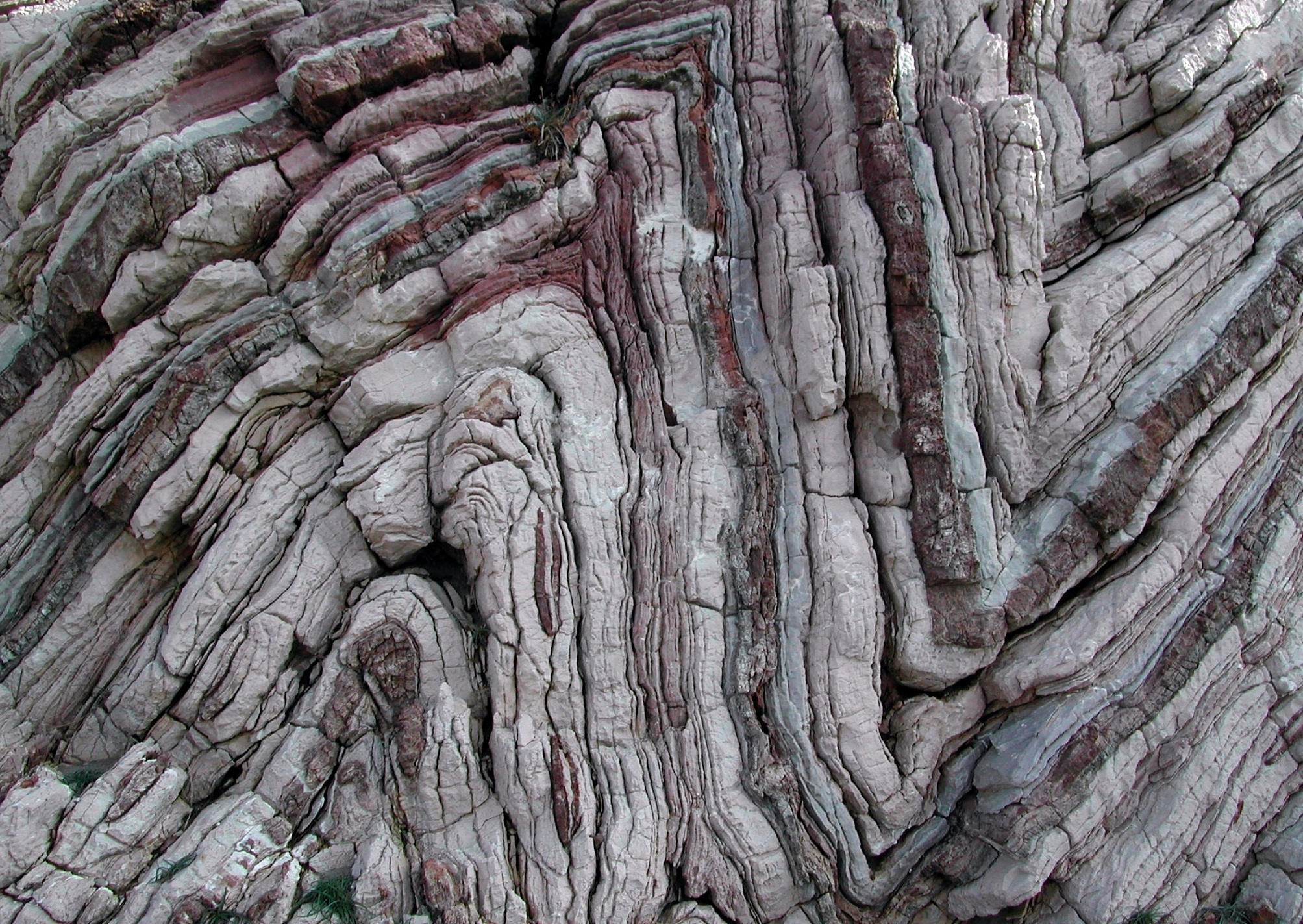
The word “Metamorphic” is Greek: meta means change and morphos means form. When rock units are buried very deeply within Earth’s crust, they are subjected to high temperatures and pressures. These rocks are squeezed and warped like putty in a process called Metamorphism; some of these rocks grow new minerals and textures and others lose minerals. The result of this high temperature and pressure transformation is a Metamorphic Rock.
Metamorphic rocks can involve high temperatures, but unlike igneous rocks, they do not melt into magma. They also involve the transformation of one rock type into another, but unlike sedimentary rocks, they do not reduce the original rock into fragments before reassembling. Metamorphism is a unique process that takes any type of preexisting rock (even old metamorphic units) and subjects it to heat and pressure over long periods of time until it has changed.
Metamorphism usually happens at least a couple kilometers beneath the Earth’s surface. Tectonic boundaries, in particular, cause different types of metamorphism at mountain-building cores, subduction zones, and spreading centers. The metamorphic rocks that form at elevated temperatures and pressures are categorized by both metamorphic texture and the amount of change that the original rock appears to have undergone: metamorphic grade.
Metamorphic Texture
Metamorphic texture describes the shape and orientation of mineral grains within a metamorphic rock. As the original rock is subjected to higher temperatures and pressures, some of its minerals might stretch out in a single direction, recrystallize, or enlarge. Therefore, the new metamorphic rock will have a different texture than the parent rock.
Metamorphic texture is broadly categorized as either Foliated or Non-Foliated.
Foliated Texture
Foliation is a term that describes how minerals line up along a preferred direction. Some minerals, particularly micas, are usually thin and planar by default. Rocks with foliated texture look like they have their minerals stacked together as though they were pages in a book; hence the term “folia”, or leaflike.

Why do foliated rocks form during metamorphism? At least two conditions need to be satisfied. First, the original rock must contain minerals that will easily deform or align with applied pressure into a flat plane. We know that mica minerals such as muscovite and biotite will do this as well as amphibole; however, stronger minerals like quartz and feldspar will often resist most pressure in the Earth’s crust.
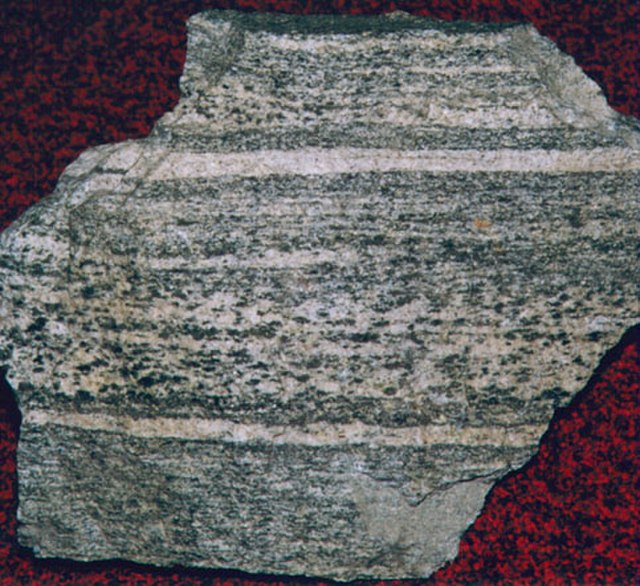
The second requirement needed for a foliated texture is directed pressure called differential stress. If pressure is applied unevenly, the weak minerals in the original rock will easily deform into long planes. This type of stress could be squeezing (compression), stretching (tensional), or sliding (shear) the rock unit.
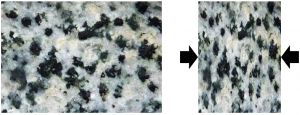
Non-Foliated Texture

Non-foliated metamorphic rocks do not have any preferential alignments of mineral grains. These rocks are also called “Granoblastic“, which references the tendency of the individual grains to have somewhat equal shapes and dimensions. The majority of a non-foliated metamorphic rock contains mostly one mineral. Nonetheless, metamorphism has still taken place within these rocks; the mineral grains have recrystallized, interlocked, and grown larger. As a consequence, non-foliated rocks are much more durable and resistant to weathering than their parent rocks.
NOTE: To receive credit for this activity, be sure to click on “Results” when you are finished!
Metamorphic Grade
Metamorphic Grade refers to extent in which metamorphism can transform the the preexisting rock. This original rock is called the parent rock, and it can undergo low-grade metamorphism (little metamorphic change) to high-grade metamorphism (significant metamorphic change).
Low-grade metamorphism begins at temperatures and pressures that are not much higher than those that form sedimentary rocks. This type of metamorphism often results from rocks being buried at depths of at least 2 km. The conditions in such an environment are typically low-temperature and pressure. The parent rock still transforms into a new metamorphic rock; however, it is often easy to identify visual similarities between the resulting metamorphic rock and original rock.
High-grade metamorphism requires both high temperatures and pressures. Burial depths for high-grade metamorphic rocks can be up to 35 km! Mountain-building centers and subduction zones are prime examples of regions where high-grade metamorphism might take place. When a parent rock undergoes metamorphism at these conditions, the resulting metamorphic rock bears very few similarities to the original specimen; it often has strong foliation or banding of minerals.
Metamorphic rocks are often not restricted to either low or high-grade. Geologists typically rank these rocks on a scale of how many (or few) similarities they bear to the parent rock. In a sequence or outcrop filled with metamorphic rocks, you might observe some units that appear similar to the parent rock and others that look nothing like it. In general, the following rocks have been ranked in order of increasing metamorphic grade:
Metamorphic Rock Field Guide
Slate

“SLAYTE”
Most commonly confused with: Shale, Phyllite
A foliated, low-grade metamorphic rock. Slate is fine-grained and composed of clays, and mica minerals that are usually too small to see with the naked eye. Slate displays strong foliation in thin sheets or layers that sometimes resemble sedimentary bedding or the linae of shale. It is usually dark gray in color, but it can also be red, green, brown, and even blue.
Although slate often forms from shale and bears a strong resemblance to this parent rock, its foliation pattern is typically more pronounced. Slate is also sometimes confused with a higher grade metamorphic rock, phyllite, which contains visible grains of mica minerals.
Slate will easily break into sheets along its foliation planes but the silicate minerals that compose its fine-grained structure make it durable against physical weathering processes directed perpendicular to the foliation line. Slate is therefore used as a building material for roofs and tiles in construction.
Phyllite
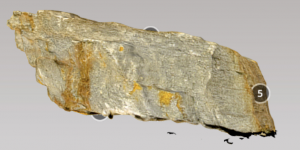
“FY-LITE”
Most commonly confused with: Slate, Schist
A foliated, low to medium-grade metamorphic rock. Phyllite is fine-grained and composed mostly of quartz, feldspar, and visible flakes of mica minerals. These enlarged mica crystals give phyllite a shimmering or silky appearance under light. Phyllite, like slate, is foliated with thin sheets that sometime separate into uneven layers that give an individual rock a wavy appearance.
The color of phyllite is often gray, black, tan, or green, and it is sometimes confused for either slate or schist. Phyllite can generally be thought of a version of slate that has undergone more metamorphism; it can be distinguished from slate by its visible, glittering mica minerals. By contrast, phyllite can very broadly be thought of as the lower-grade version of schist. Schist has much larger, foliated plates of mica.
Schist
“SHIST”
Most commonly confused with: Phyllite
A foliated, medium-grade metamorphic rock. Schist contains large, leaflike grains of mica such as muscovite and biotite, that are strongly oriented into a single direction. Some varieties of schist have garnets, which only form at elevated temperatures and pressures, although most schists also contain quartz and feldspar. Due to the presence of large mica plates and their flattened orientation, schist is usually shiny or vitreous under light.
Schist is often gray or brown in color, and it is sometimes confused with phyllite, which contains smaller grains of mica. Schist can also be identified by its strong foliation pattern, which is called “schistosity”. This pattern is much more pronounced than lower grade metamorphic rocks such as slate and phyllite.
Gneiss
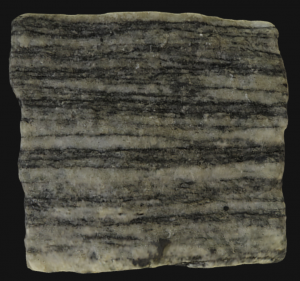
“NICE”
Most commonly confused with: Granite, Diorite
A foliated, high-grade metamorphic rock. Gneiss has a visible separation of light and dark bands, which is called lineation. Gneiss is coarse-grained and mostly contains silicate minerals that are resistant to high temperatures such as quartz, feldspar, biotite, and garnet. The banding pattern on gneiss is usually wavy or folded, which reflects how the parent rock deformed like putty at extremely high temperatures and pressures; indeed, sometimes the rock partially melts.
Gneiss is occasionally mislabeled as the igneous rock granite or diorite. Although gneiss may contain similar silicate minerals as these rocks, it is distinctively banded, whereas the igneous rocks are granular and have no preferred orientation. Because gneiss is not easily broken into sheets, it is a useful construction material in landscaping and architecture.
Marble
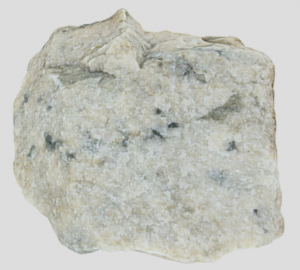
Most commonly confused with: Quartzite
A non-foliated metamorphic rock. Marble forms under low grade or high-grade metamorphism, although at the latter it will grow larger, more interlocked crystals that reflect its higher temperature and pressure origins. The parent rock of marble is limestone, although marble typically appears to have more identifiable grains. Marble contains the mineral calcite and/or dolomite, and it may fizz with dilute hydrochloric acid.
Marble is light in color, and it can be white, pink, tan, or gray. Some varieties of marble look similar to another non-foliated metamorphic rock, quartzite. However, the minerals calcite and dolomite that primarily compose marble are much softer than those found in quartz, and marble is easier to scratch with an iron nail.
Although marble that contains calcite will react to acidic rainwater and groundwater over long periods of time, marble has traditionally been a sculpting material in art and architecture for thousands of years. Polished material remains a popular building and decorative material to this day.
Quartzite
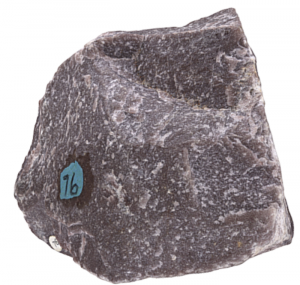
Most commonly confused with: Marble, Sandstone
A non-foliated, high-grade metamorphic rock. Quartzite only forms from the sedimentary rock sandstone, and it almost exclusively contains quartz. The high temperatures and pressures in the metamorphic environment have caused the individual quartz grains to increase in size and interlock.
Quartzite is usually light tan or pink in color and coarse-grained. Like other rocks that predominately contain silica, it can display conchoidal fracture, although it is very resistant to mechanical breakage. Although this rock can look similar to marble, it will not fizz in contact with dilute hydrochloric acid, and it will not easily scratch.
Quartzite is also more durable than its parent rock, sandstone, which weakly cements sand grains together. For example, if sandstone is hit with a rock hammer, the individual grains will remain intact and the cement would crumble. If quartzite is hit with a rock hammer, it would probably spark from the friction and cause the hammer to bounce back, and, thus, is NOT recommended!
Quartzite will resist both chemical and physical weathering. As such, this rock has been used for thousands of years as a tool, construction, manufacturing, and architectural material.
Note: The below exercise is for practice only. It will not affect your total Knowledge Check score!
The thin, outermost layer of Earth composed of rigid rock, which is home to all known life on the planet.
The alteration of preexisting rock by elevated temperatures or pressures, usually beneath the Earth's surface.
a solid, inorganic, and crystalline substance that has a predictable chemical composition and form by natural processes.
Rocks that form when any type of preexisting rock is warped or transformed under elevated temperatures and pressures.
Rocks that crystallize from molten materials beneath the Earth surface or from volcanic processes.
molten rock that can be found beneath the Earth's surface.
rocks that cement together from weathering products, either from sediments or chemical ions in water.
The process in which the older, denser tectonic plate at a convergent boundary will buckle and sink into the lithosphere. This plate will always be composed of oceanic lithosphere.
A region on the ocean floor where magma from an active divergent boundary is creating new oceanic lithosphere, thus pushing or spreading the older lithosphere outwards.
A process (usually in metamorphism) in which high temperatures and pressures cause the atoms within solid mineral structures to rearrange.
An original rock from which a new rock (usually metamorphic) is formed.
A type of metamorphic texture in which the rock has repetitive layering or minerals lined along a preferred direction due to the uneven application of heat and pressure.
A type of metamorphic rock texture that indicates the lack of layering or preferred alignment of minerals. Non-foliated rocks are granular and usually contain interlocking mineral grains. Also known as granoblastic.
The arrangement of thin layers or repetitive structures in metamorphic rocks that results from the uneven applications of heat and pressure within the Earth's surface.
A group of silicate minerals called the "sheet" silicates. Mica minerals have their atomic structure arranged to easily pull apart as sheets in one direction.
A common mineral in the mica group that is light grayish-brown. It is flaky and peels apart in sheets.
A type of mica that is black or dark-colored and is typically found in igneous and metamorphic rocks.
a class of silicate minerals that are usually dark and form long crystals (as prisms or needles). Amphiboles are often magnesium (Mg) and iron (Fe) rich in composition.
A very common rock-forming silicate mineral with formula SiO2.
A group of silicate minerals which represents the most abundant mineral class of the continental crust.
An uneven application of force against a material, such as a unit of rock, usually during metamorphism.
A type of force placed on an area of rock that presses or squeezes it tighter together.
A type of force placed on an area of rock that pulls or moves it apart.
A type of force placed on an area of rock that causes deformation with a sliding motion.
A non-foliated rock texture in metamorphic rocks, in which there is no preferred alignment of minerals or layering. Individual mineral grains of somewhat equal to one another in dimension.
A clastic sedimentary rock made of very fine-grained sediments such as muds, clays, and silts.
A foliated, low to medium-grade metamorphic rock that typically has visible flecks of mica, which causes a "shimmer"-like quality.
A foliated and fine-grained, low-grade metamorphic rock that is originally made from shale.
A group of silicate minerals that typically forms after existing rocks and minerals, such as feldspars, are chemically altered by water.
A mineral class that is primarily composed or defined by silicon (Si) and oxygen (O).
A type of weathering that involves the abrasion and breakdown of existing rocks and minerals by water, the atmosphere, and biosphere. Also known as mechanical weathering.
A strongly foliated, medium-grade metamorphic rock with large, leaf-like grains of mica and sometimes red garnets.
X3Y2(SiO4)3
A group of hard silicate minerals that form under high pressures and temperatures. Garnets can have dodecahedral habit and are commonly found in metamorphic rocks, such as schist.
Reflective and glassy luster.
A felsic, intrusive rock with coarse-grained texture. Granite composes mountain cores and can be found on and within the continental crust.
An intermediate, extrusive igneous rock that is coarse-grained. The presence of large black and white crystals on the rock have a "dalmation"-like appearance.
A foliated, high-grade metamorphic rock distinguished by its strong preferred orientation, or banding, of light and dark minerals.
The strong preferred orientation of mineral grains in a metamorphic rock, which is seen as a banding or separation of light and dark minerals. Lineation is categorized under the umbrella term "foliation".
A non-foliated (granoblastic) metamorphic rock that was once a quartz-rich sandstone.
A non-foliated metamorphic rock that forms from limestone.
An organic or chemical sedimentary rock that is primarily composed of calcium carbonate (CaCO3). Limestone is a subgroup of rocks that includes chalk, coquina, and fossiliferous limestone.
CaCO3
A carbonate mineral that strongly reacts with dilute acid. Calcite composes the sedimentary rock limestone and composes the skeletons of some ocean life.
A carbonate mineral, CaMg(CO3)2, that is more resistant to weathering by acid at room temperatures. Dolomite often composes the material of fossilized shells.
A type of clastic sedimentary rock that is composed of sand-sized clasts.
a compound composed of silicon and oxygen in the formula SiO2.
The breakage of a rock or mineral that forms smooth, curved surfaces.
The process in which fluids, such as water, move into the pore spaces between loose sediments and - through chemical reactions - act as a bonding agent between the grains.
The dissolution, disintegration, and alteration of preexisting rock by reactions that take place at the molecular scale.

